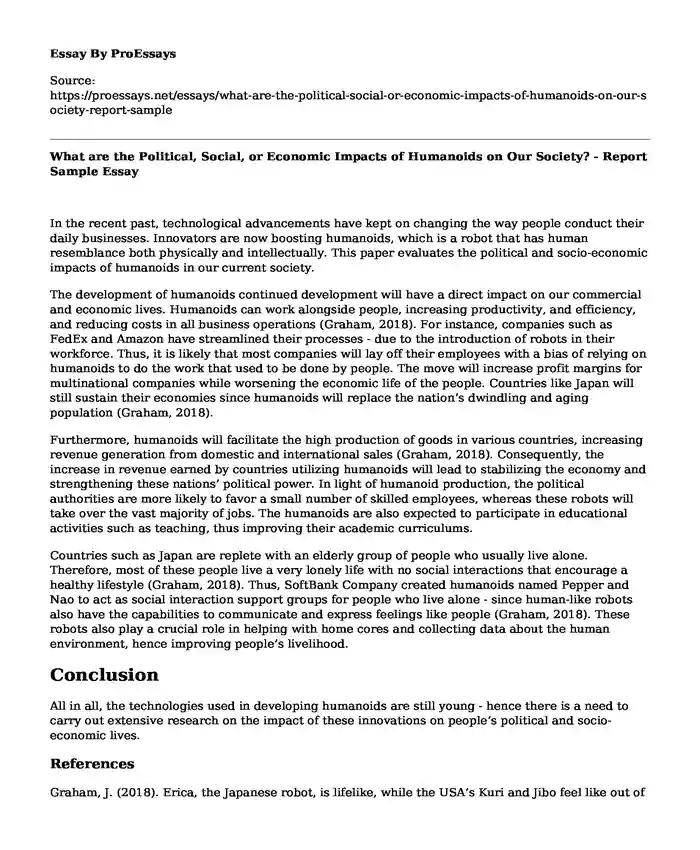In the recent past, technological advancements have kept on changing the way people conduct their daily businesses. Innovators are now boosting humanoids, which is a robot that has human resemblance both physically and intellectually. This paper evaluates the political and socio-economic impacts of humanoids in our current society.
The development of humanoids continued development will have a direct impact on our commercial and economic lives. Humanoids can work alongside people, increasing productivity, and efficiency, and reducing costs in all business operations (Graham, 2018). For instance, companies such as FedEx and Amazon have streamlined their processes - due to the introduction of robots in their workforce. Thus, it is likely that most companies will lay off their employees with a bias of relying on humanoids to do the work that used to be done by people. The move will increase profit margins for multinational companies while worsening the economic life of the people. Countries like Japan will still sustain their economies since humanoids will replace the nation’s dwindling and aging population (Graham, 2018).
Furthermore, humanoids will facilitate the high production of goods in various countries, increasing revenue generation from domestic and international sales (Graham, 2018). Consequently, the increase in revenue earned by countries utilizing humanoids will lead to stabilizing the economy and strengthening these nations’ political power. In light of humanoid production, the political authorities are more likely to favor a small number of skilled employees, whereas these robots will take over the vast majority of jobs. The humanoids are also expected to participate in educational activities such as teaching, thus improving their academic curriculums.
Countries such as Japan are replete with an elderly group of people who usually live alone. Therefore, most of these people live a very lonely life with no social interactions that encourage a healthy lifestyle (Graham, 2018). Thus, SoftBank Company created humanoids named Pepper and Nao to act as social interaction support groups for people who live alone - since human-like robots also have the capabilities to communicate and express feelings like people (Graham, 2018). These robots also play a crucial role in helping with home cores and collecting data about the human environment, hence improving people’s livelihood.
Conclusion
All in all, the technologies used in developing humanoids are still young - hence there is a need to carry out extensive research on the impact of these innovations on people’s political and socio-economic lives.
References
Graham, J. (2018). Erica, the Japanese robot, is lifelike, while the USA’s Kuri and Jibo feel like out of a cartoon. USA Today. https://www.usatoday.com/story/tech/talkingtech/2018/02/19/erica-humanoid-robot-chatty-but-still-has-lot-learn/352281002/
Cite this page
What are the Political, Social, or Economic Impacts of Humanoids on Our Society? - Report Sample. (2024, Jan 09). Retrieved from https://proessays.net/essays/what-are-the-political-social-or-economic-impacts-of-humanoids-on-our-society-report-sample
If you are the original author of this essay and no longer wish to have it published on the ProEssays website, please click below to request its removal:
- The Need for Aggiornamento - Essay Sample
- Essay Sample on Mexican Drug Cartels and Organizations
- Essay Sample on Disparities Among the Minority and Criminal Justice
- Research Paper on Corruption and Deviance in Policing
- Effective Communication in Healthcare: A Case Study of Kirra
- Diversity in Communication: A Boost for Global Teams - Essay Sample
- Essay Sample:The Great Recession's Impact on People with Disabilities







